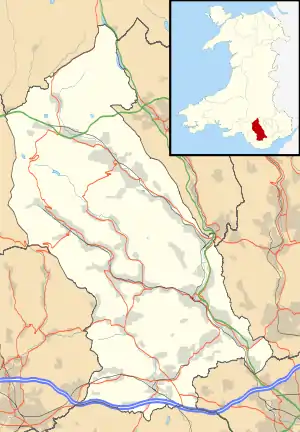Tonypandy
Tonypandy /tɒnəˈpændi/ is a town and community located in the county borough of Rhondda Cynon Taf, within the historic county boundaries of Glamorgan, Wales, lying in the Rhondda Fawr Valley. A former industrial coal mining town, today Tonypandy is best known as the site of the 1910 Tonypandy riots.
| Tonypandy | |
|---|---|
 Tonypandy Square (2007) | |
 Tonypandy Location within Rhondda Cynon Taf | |
| Population | 3,750 (2011)[1] |
| OS grid reference | SS995925 |
| Principal area | |
| Ceremonial county | |
| Country | Wales |
| Sovereign state | United Kingdom |
| Post town | TONYPANDY |
| Postcode district | CF40 |
| Dialling code | 01443 |
| Police | South Wales |
| Fire | South Wales |
| Ambulance | Welsh |
| UK Parliament | |
| Senedd Cymru – Welsh Parliament | |
Toponomy
Tonypandy means fulling mill lea, from Welsh ton (archaic tonnau) for lea, layland, pasture, grassland or unploughed land; pannu for fulling and tŷ for house (cf. pandy). (See also Tonna.)
History
Pre-industrial
The Tonypandy area contains several prehistoric sites, the main one being Mynydd y Gelli. Located to the north-west of the town, the remains of an Iron Age settlement Hen Dre'r Gelli lies on the slopes of Mynydd Y Gelli hill between Tonypandy and Gelli. Near the same location are several Bronze Age cairns.[2]:14
Tonypandy is also the site of one of two permanent Middle Ages fortifications found within the Rhondda Valley. Named Ynysygrug, it was a lesser motte and bailey earthwork defence consisting of a wooden tower surrounded by a small fortified courtyard.[2]:26 Built around the 12th or early 13th century, the remains of the fortification were mostly destroyed during railway construction works in the 19th century. The fortification was for many years wrongly thought to be the burial place of Rhys ap Tewdwr or a druidic worship site.[2]:26
The regional library service recounts that the name 'Tonypandy' means the meadow of the fulling mill which was established there in 1838. "E. D. Lewis in his work The Rhondda Valleys provides us with an outline history of the mill that once stood in Tonypandy, and from which the town took its name".[3]
Industrial era
In the mid-19th century, the Rhondda began its industrial transformation after the successful excavation of coal. With the extension of the Taff Vale Railway to Treherbert and Maerdy in 1856, the Rhondda grew as absentee landlords switched their interests from farming to mining. The Tonypandy riots of 1910 and 1911 were a series of violent confrontations between coal miners and police that took place at various locations in and around the Rhondda mines of the Cambrian Combine, a cartel of mining companies in South Wales. Tonypandy, unlike the surrounding villages, then grew as a financial and social hub, providing services and amenities for the neighbouring communities. Served by Tonypandy railway station, it is the largest shopping area in the Rhondda and is now largely pedestrianised.[4]
Sports and recreation
In the early part of the 20th century, Tonypandy was home to Mid-Rhondda RLFC, one of the first Welsh rugby league teams.[5] Although surviving only one season, the club transformed into Mid-Rhondda AFC, one of the most notable association football teams the Rhondda has produced. Both Mid-Rhondda teams played at the Athletic Ground, now known as "the Mid" . The pitch is notable as having hosted the first international match between the Wales and England rugby league teams on 20 April 1908.[6] It was also used as the opening venue for the 1908–09 Kangaroo tour of Great Britain, when the visiting Australian rugby league team began its campaign with a match against Mid-Rhondda.[7]
When the Mid-Rhondda RLFC collapsed in 1909, the committee refocused on creating an association football team. In 1912 Mid Rhondda F.C. was formed, winning the South League Second Division in 1919–20.
Notable people
- See Category:People from Tonypandy
- Willie Llewellyn (1878 – 1973), Welsh national rugby captain and three times Triple Crown winner
- Writer Rhys Davies (1901 – 1978)
- George Thomas, 1st Viscount Tonypandy (1909 – 1997) was educated at Tonypandy Grammar School.[8]
- Boxer Tommy Farr (1913 – 1986), the "Tonypandy Terror", trained there, living in adjoining Clydach Vale
- Brothers Donald Houston (1923 – 1991) and Glyn Houston (1926 - 2019) were both actors
- Len Rawle (b. 1938), organist and organ builder/restorer
- Footballer and club manager Nathan Jones (b. 1973)
- Footballer Alex Lawless (b. 1985)
- Singer and actress Sophie Evans (b. 1993)
References
- "Town population 2011". Retrieved 17 November 2015.
- Davis, Paul R. (1989). Historic Rhondda. Ynyshir: Hackman. ISBN 0-9508556-3-4.
- Heritage trail (Tonypandy) Archived 2008-08-20 at the Wayback Machine Rhondda Cynon Taf Library Service
- "Tonypandy...a peaceful town benefiting from a commitment to the regeneration of the Victorian town centre". Rhondda Cynon Taf County Borough Council. Retrieved 4 April 2018
- Lush, Peter; Farrar, Dave (1998). Tries in the Valley: A History of Rugby League in Wales. London: London League Publications. pp. 31–32. ISBN 0-9526064-3-7.
- Gate, Robert (1986). Gone North: Volume 1. Ripponden: R. E. Gate. p. 141. ISBN 0-9511190-0-1.
- Sean Fagan Kangaroo Tour: 1908-1909 Archived 2008-05-23 at the Wayback Machine (2006) at website RL1908.com
- George Thomas (Lord Tonypandy) at Port Talbot Historical Society. Accessed 29 April 2016
External links
| Wikimedia Commons has media related to Tonypandy. |


